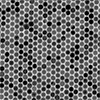| Dec 01, 2023 |
|
(Nanowerk News) Hydrogen is a building block for the energy transition. To obtain it with the help of solar energy, LMU researchers have developed new high-performance nanostructures. The material holds a world record for green hydrogen production with sunlight.
|
|
When Emiliano Cortés goes hunting for sunlight, he doesn’t use gigantic mirrors or solar farms. Quite the contrary, the professor of experimental physics and energy conversion at LMU dives into the nanocosmos.
|
|
“Where the high-energy particles of sunlight meet atomic structures is where our research begins,” Cortés says. “We are working on material solutions to use solar energy more efficiently.”
|
|
His findings have great potential as they enable novel solar cells and photocatalysts. But there is one major challenge, Cortés knows: “Sunlight arrives on Earth ‘diluted,’ so the energy per area is comparatively low.”
|
|
Solar panels compensate for this by covering large areas. Cortés, however, is approaching the problem from the other direction, so to speak: With his team at LMU’s Nano-Institute, which is funded by the e-conversion cluster of excellence, Solar Technologies go Hybrid (an initiative of the Bayerisches Staatsministerium für Wissenschaft und Kunst) and the European Research Council, he is developing plasmonic nanostructures that can be used to concentrate solar energy.
|
|
In a publication in the journal Nature Catalysis (“Plasmonic Bimetallic Two-Dimensional Supercrystals for H2 Generation”), Cortés, together with Dr. Matías Herran and cooperation partners from the Free University of Berlin and the University of Hamburg, present a two-dimensional supercrystal that generates hydrogen from formic acid with the help of sunlight.
|
|
“The material is so outstanding, in fact, that it holds the world record for producing hydrogen using sunlight,” Cortés points out.
|
Nano hotspots unleash catalytic power
|
|
For their supercrystal, Cortés and Herrán use two metals in nanoscale format. “We first create particles in the range of 10-200 nanometers from a plasmonic metal – which in our case is gold,” Herrán explains. “At this scale, visible light interacts very strongly with the electrons of gold, causing them to oscillate resonantly.”
|
|
This allows the nanoparticles to capture more sunlight and convert it into very high-energy electrons. “Highly localized and strong electric fields occur, the hotspots,” says Herrán. These form between the gold particles, which gave Cortés and Herrán the idea of placing platinum nanoparticles right in the interspaces. In the hotspots, we can enable it to convert formic acid into hydrogen,” Herrán explains.
|
|
With a hydrogen production rate from formic acid of 139 millimoles per hour and per gram of catalyst, the photocatalytic material currently holds the world record for H2 production with sunlight.
|
An impetus for greener hydrogen production
Today, hydrogen is primarily produced from fossil fuels, predominantly from natural gas. “By combining plasmonic and catalytic metals, we are advancing the development of potent photocatalysts for industrial applications, such as the conversion of CO2 into usable substances,” Cortés and Herrán explain. The two researchers have already patented their material development.
|

